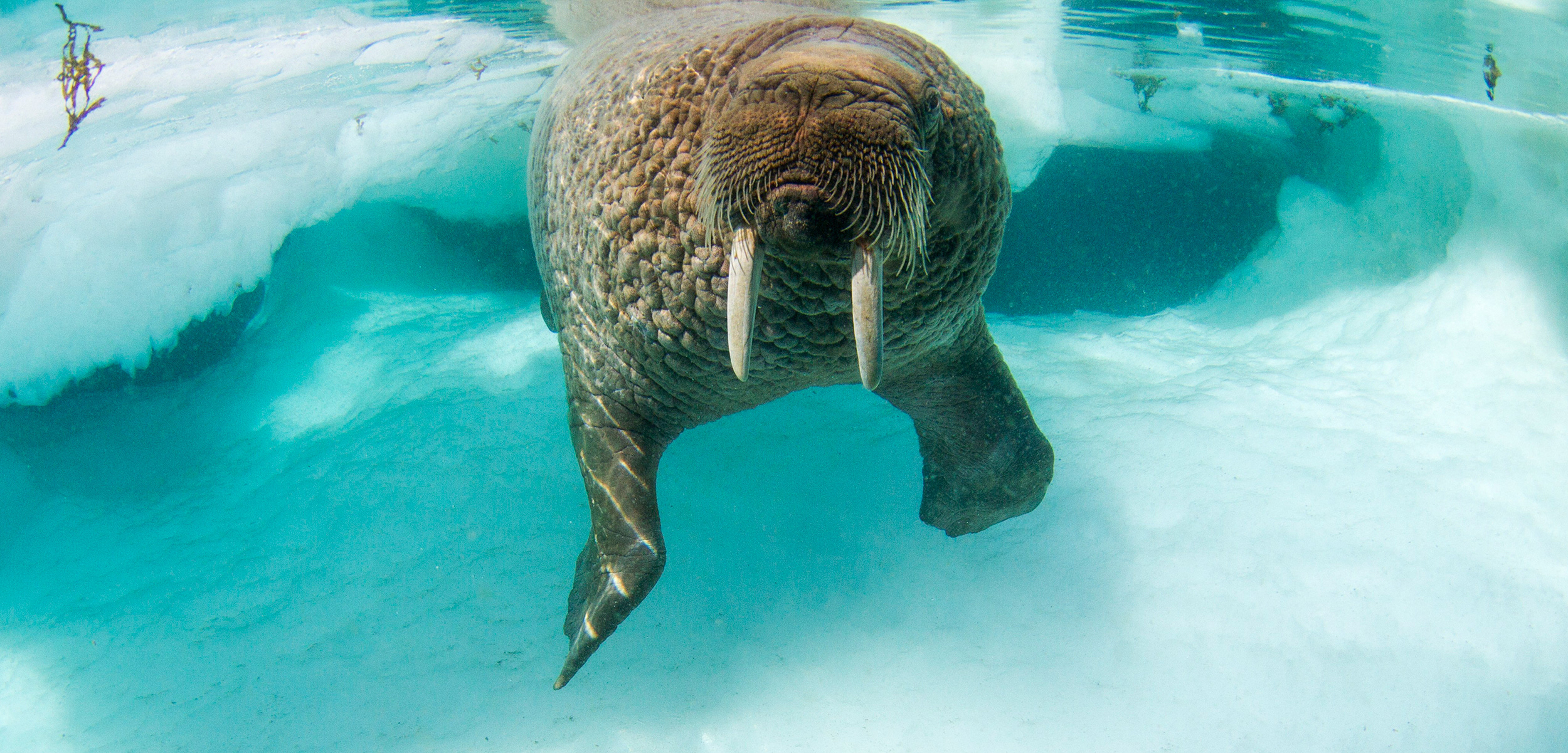What Now, Walrus?
The convergence of Inuit wisdom and scientific study is helping researchers begin to understand what a changing Arctic means for the walrus (and for those who depend on it).
Article body copy
The air is calm this Arctic morning as Zacharias Kunuk prepares for a long day. His morning routine does nothing to quell his nerves—today he’s going on his first walrus hunt.
It’s 1980, late July—the month walrus hunters climb into motorized freighter canoes and leave Igloolik, a small Inuit community in Nunavut, Canada. Every summer since he was a boy, Kunuk has watched the hunters return, weary but triumphant with walrus meat. He’s always wondered how far these men travel to reach the floating rafts of ice where walruses rest during the summer. And he’s pondered how just a few men can possibly kill a creature that might weigh more than 20 men and then wrestle it into a canoe. This is the day Kunuk will get answers. He also plans to capture it all on camera. A young filmmaker in his mid-20s, Kunuk has a small budget to finance the hunt, a cultural practice so vital to his community’s identity that he wants to record it for future generations.
The temperature on an Arctic summer day rarely exceeds 10 °C, with much cooler air out by the sea ice, so the hunters dress for the climate: skin boots, mittens, and knee-length parkas with fur-lined hoods. Kunuk joins an experienced elder and the man’s brother as they load their boat with harpoons, guns, knives, tea, and bannock (a fry bread). Nearby, other men ready their own freighter canoes.
Then they push off—a tiny flotilla in a great big sea—on their way to hunt an enormous animal. As they travel, the hunters explain how to read the angle of the sun, the direction of the currents, and the subtle movements of the seaweed—a navigational system so baffling to young Kunuk that he silently questions how they will ever find their way home.
After several hours spent listening to the engine’s mechanical chug, Kunuk hears a chorus of mumbling and chattering, grunts and growls, a sign that they are close to the walruses. (That sound will later remind him of the cacophony in a busy bar). They shut down the motors and drift toward the ice. As the walruses lift their hefty heads, the hunters raise their rifles and aim.
Throughout the Arctic, the traditional walrus hunt happens today much like it has for thousands of years—in teams armed with knowledge about walrus behavior accumulated over generations. But times are changing, and it’s not just that the hunters now have global positioning systems, speedboats, and cell phones. A rapidly changing environment is also altering walrus behavior in ways scientists are struggling to understand. As Arctic sea ice melts at a worrisome rate—in 2015 reaching the smallest maximum extent ever recorded—walruses are behaving strangely in parts of their range. That includes gathering in unusually large numbers on land.
Normally, females and calves prefer to haul out on sea ice instead of on land with the males. But as the ice disappears, the beaches are filling up. In September 2014, 35,000 Pacific walruses piled together near the village of Point Lay, Alaska, making international headlines for a record-setting heap of jostling tusks and whiskers on American soil. In October 2010, 120,000 walruses—perhaps half the world’s population—crowded onto one Russian haul-out site.
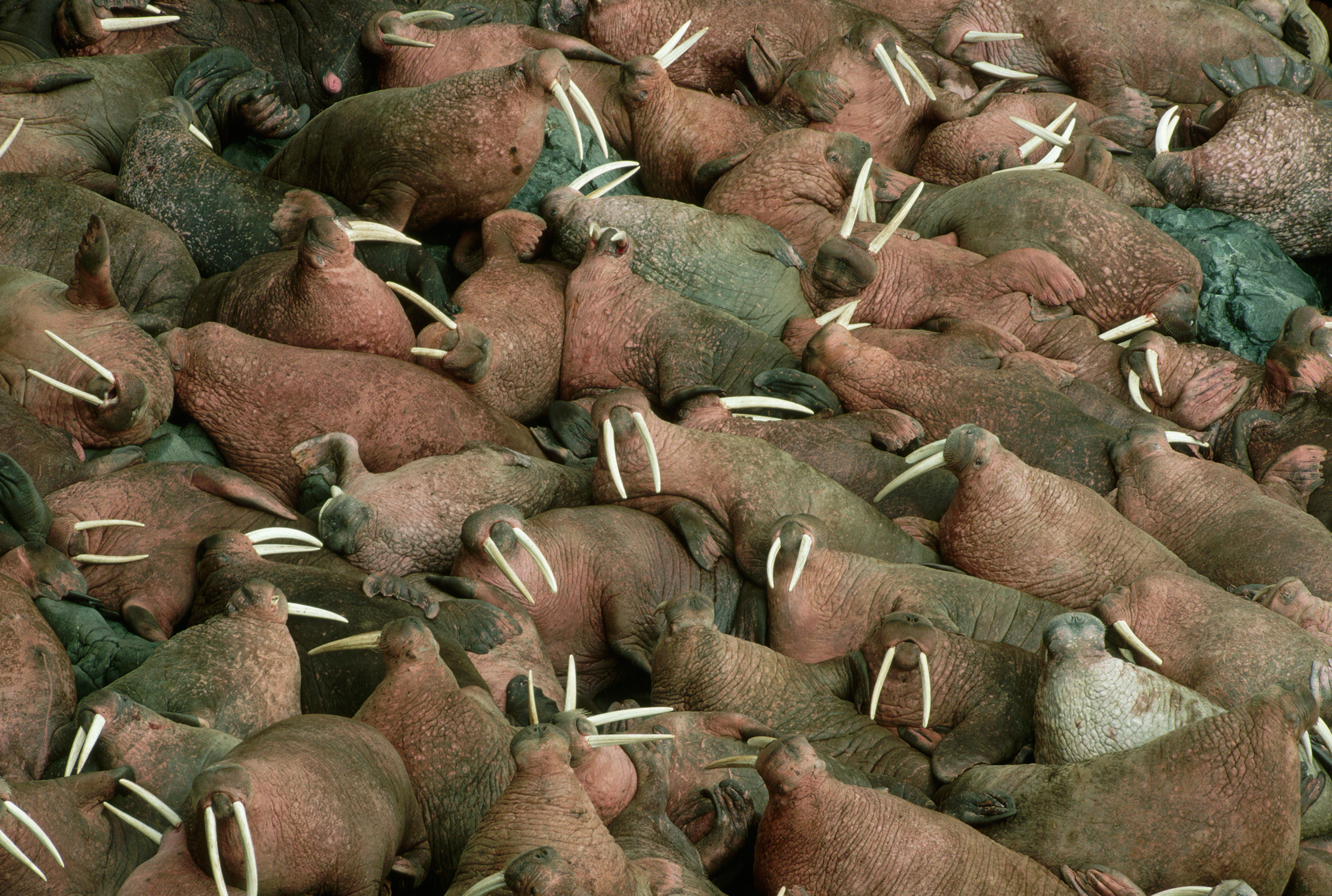
Round Island is one of the four main terrestrial haul-out sites for male walruses in Alaska. They gather here in the spring when the sea ice recedes and as many as 14,000 walruses have been counted on a single day. Photo by Tom Bean/Corbis
For their part, scientists are racing to gather information about walruses, including attempts to get the first accurate head count amidst increased shipping traffic, proposed oil drilling, and other disturbances in key walrus habitat. A 2017 deadline for a decision by the United States government on whether to list walruses under the Endangered Species Act is fueling a new sense of urgency. A major goal is to explain changing walrus behaviors and understand what, if any, protections they might require. But there is another unanswered question that is just as critical, if less quantifiable: What do new walrus behaviors mean for indigenous people who have long depended on the animals?
Though related, these questions represent a clash between two contradictory ways of seeing the natural world. There’s science, which respects numbers and data above all else. And then there’s traditional knowledge, which instead prioritizes relationships between people and animals. In the Inuit view, walruses have a sense of personhood and agency, says Erica Hill, an anthropologist at the University of Alaska Southeast in Juneau. They act and react. As Kunuk points out, animal populations—caribou, fish, seals, and walruses—have always cycled. Unlike the scientists, the Inuit feel it’s best not to talk about how many come by each year. The animals might overhear, feel disrespected, and choose to stay away.
“If we talk about the walrus too much, they’re going to change,” says Kunuk. “If we were farmers we would count our stock. But we’re hunters and these are wild animals.”
Because scientists and hunters use wholly different systems to process knowledge, merging what they know is like trying to read a book in a foreign, if slightly familiar, language. Still, both worldviews share a deep caring for the animals, suggesting that a true understanding of the walrus may come only by allowing each perspective to teach the other. To accurately interpret emerging science, perhaps researchers must incorporate a much deeper history, one embedded in native traditions.
Walruses—and the people who have long relied on them—have, after all, been dealing with hunters, climate variations, and other obstacles for centuries. And Inuit hunters know that walruses have repeatedly adapted to change with more resilience than several decades of scientific data can detect. Within that intricate relationship may lie important lessons for maintaining a delicate balance between species that have coexisted in a harsh and unpredictable environment for millennia. This often-overlooked complexity adds a twist to the standard narrative surrounding Arctic creatures—that environmental change leads to certain catastrophe. It might not be so simple.
“We’re really good in the science world at seeing how things can go wrong, like ‘Gee, walruses need ice and the ice is going away, so whoops, we have a problem,’” says anthropologist Henry Huntington, who has been interviewing native hunters to complement a walrus satellite-tagging study by the Alaska Department of Fish and Game. “We know that ice is getting thinner in the summer, and it is easy to draw a straight line and extrapolate and say that at the end of this line is doom and gloom for the walrus population. What we’re not good at anticipating is what adjustments walruses can make. Walrus hunters are able to put that in perspective.”
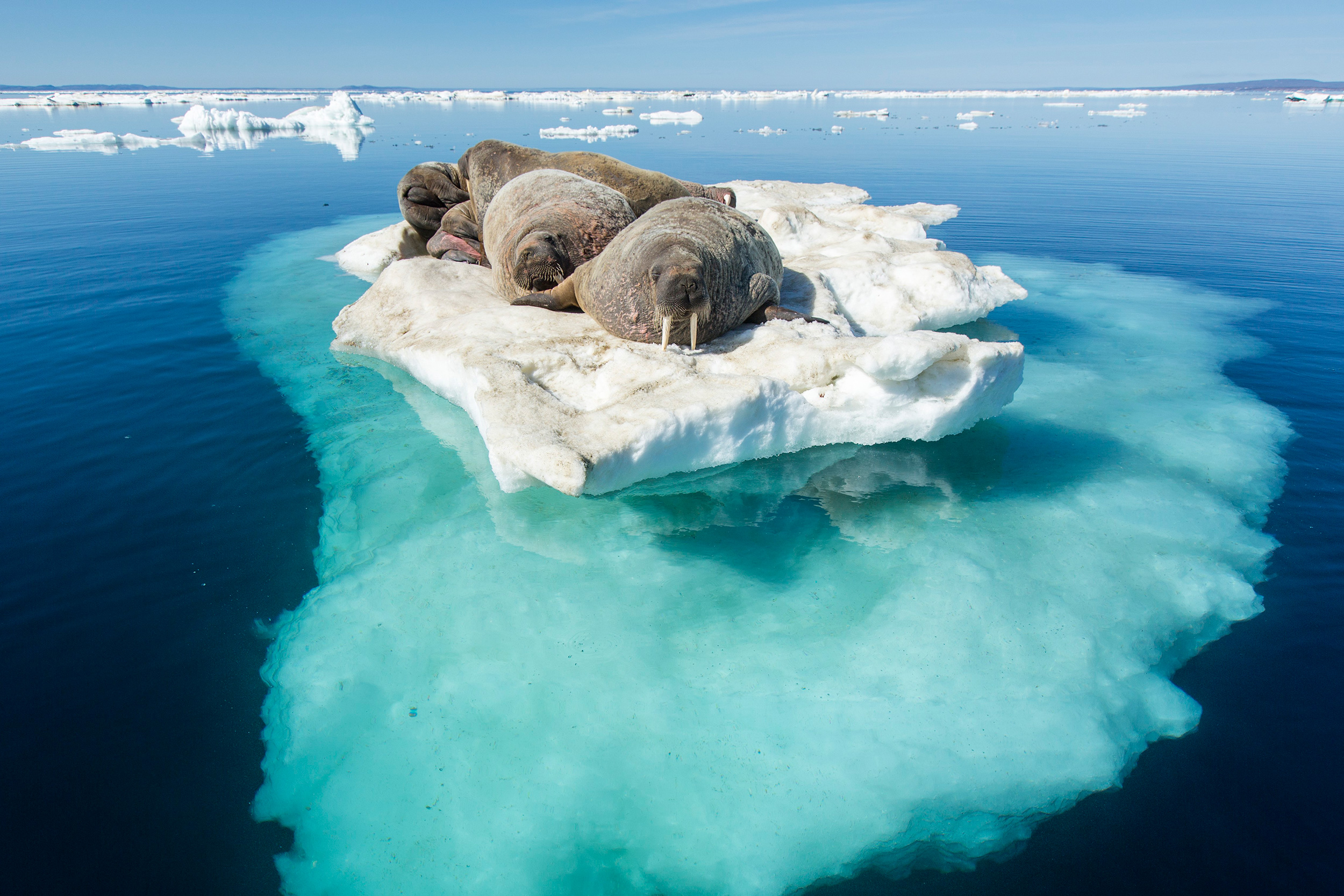
Walruses rest on floating rafts of sea ice throughout the Arctic. Changes in the extent of sea ice cover is leading to changes in walrus behavior. Photo by Paul Souders/Corbis
On that first expedition some three decades ago, young Kunuk watched and filmed as the hunters shot and butchered walruses, then wrapped parcels of meat in walrus skin. When they returned to Igloolik, he kept filming as the men dug pits for the meat in the gravel beach. After fermenting for several months, the aged meat, called igunaq, takes on the consistency of blue cheese and smells like a week-old carcass, Kunuk says. Yet once acquired, a taste for this valuable delicacy is a lifelong love, and, along with fresh, boiled walrus meat, is coveted.
For a 700-kilogram polar bear, calorie-dense walrus is also fair game and, in the emerging quagmire of changing Arctic dynamics, this is the crux. As Arctic ice melts, polar bears are spending more time on land where they’re smelling hard-won igunaq, digging up the meat, and occasionally wandering into Igloolik or other villages. A generation ago, Kunuk’s father told him that one bear a year might come into the village. But between August 2012 and January 2013, over 30 bears were seen on Igloolik Island, including in and around Igloolik village.
Along the coasts of Alaska and Russia, another temptation lures polar bears closer to villages: extra-large gatherings of live walruses that are, like the bears, increasingly driven to shore, largely because of the lack of sea ice. Walruses are notoriously skittish and often stampede when spooked by something like a bear. In a stampede’s wake, they leave trampled animals, sometimes thousands of them. It’s like a free buffet for hungry bears.
Escalating conflicts between walruses, polar bears, and humans have prompted a new era of adaptation by indigenous communities, often with scientists supporting their efforts. In Igloolik and nearby Hall Beach, hunters are testing electric fences as deterrents to protect igunaq. Sometimes the bears get over or under the fences, but several years into the project, they have learned to avoid the live wires, which deliver a harmless but effective jolt. And communities are losing less of their valuable meat, especially when they’re vigilant about checking the fences, says Marcus Dyck, a polar bear biologist with the government of Nunavut. “I’ve seen polar bears move a thousand pounds of rocks to get at walrus meat. If a bear is determined, there’s nothing that can stop [it],” he says. “Surprisingly, electricity from the fences really spooks the shit out of them.”
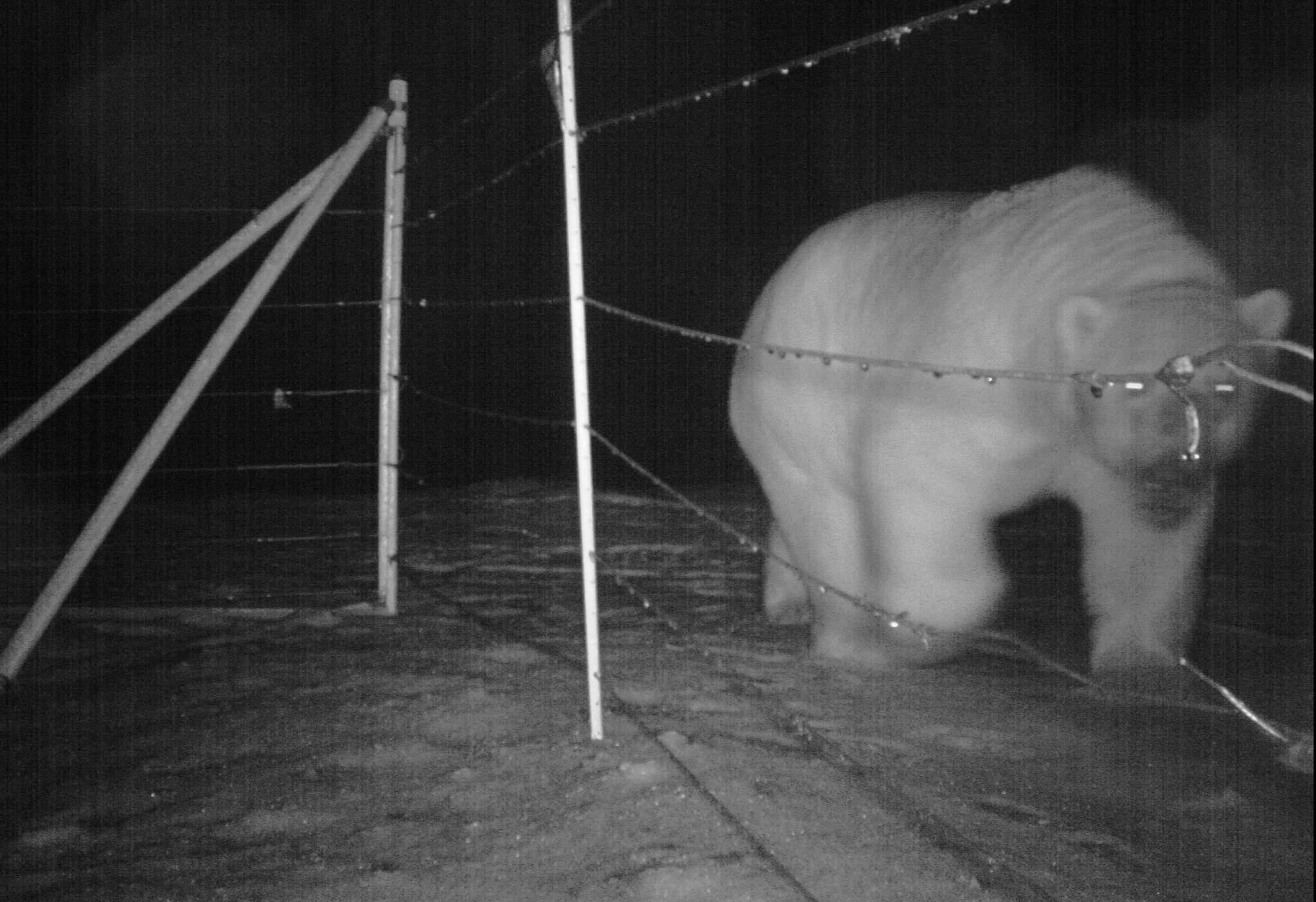
In some parts of Nunavut, electric fences are being tested as polar bear deterrents. This fence near Igloolik protects a cache of igunaq. Photo courtesy of Government of Nunavut
On the Pacific side of the Arctic, efforts to manage the walrus situation began in 2006 after a polar bear killed a teenage girl in the Russian village of Riyrkaipiy. Along with a growing sense that more polar bears were hanging around on land, the concerned villagers took charge by restricting disturbances at haul-out sites and creating umky (polar bear) patrols to chase bears away with flares, pots and pans, and rubber bullets. Their work was so effective that at least seven communities now have active polar-bear patrol teams that keep watch along the northern coastline of Russia. In Alaska, communities are managing walrus stampedes in terrestrial haul-out sites—and thus deterring bears—by minimizing noise and other human-caused disturbances. Low-flying planes are diverted, film crews turned away, and hunting is avoided in an attempt to keep the herds calm.
The people who live among walruses, in other words, are adapting to new realities. But what about the walruses? What do the numbers show?
Before the onset of industrial European walrus hunting in the 19th century, it is estimated that hundreds of thousands of walruses swam freely throughout the Arctic. But the animals became so valued for their oil, meat, skin, and ivory that by the 1950s the population had fallen as low as 50,000. After a recovery that peaked in the 1980s, when there seemed to be more walruses than the environment could support, numbers declined again. Today, the best available data suggests that there may be as many as 25,000 Atlantic walruses and some 200,000 Pacific walruses.
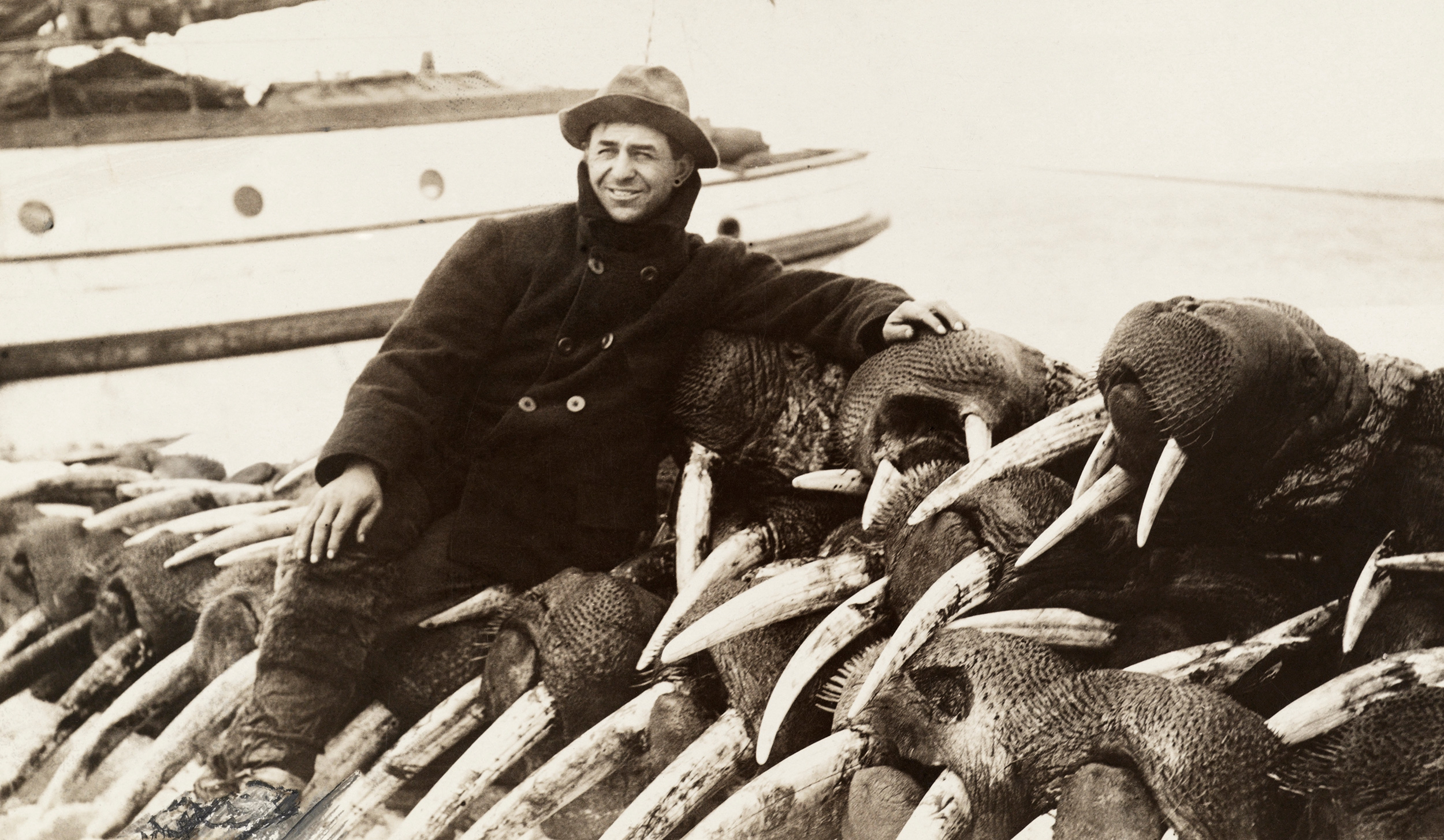
Walruses have been hunted by indigenous populations for generations, but the large-scale commercial exploitation of the animals—primarily for blubber and tusks—caused populations to reach an all-time low in the 1950s. Restrictions have since seen populations rebound. Photo courtesy of Dobbs/National Geographic Creative/Corbis
But nobody knows for sure. Walruses spend a lot of time underwater, diving for shellfish on the seafloor. And they tend to clump within an enormous range that is both inaccessible and inhospitable to people, which means that extrapolating the size of an entire population by surveying a fraction of the environment can lead to wild miscalculations. The last attempt to make an aerial count of Pacific walruses, in 2006, came up with an estimate of 129,000 individuals, but error margins were huge. The possible range was between 55,000 and 507,000.
“They’re the gypsies of the sea and they’re a very challenging species to study,” says Rebecca Taylor, a research statistician with the United States Geological Survey (USGS) Alaska Science Center in Anchorage. “If you find walruses, you often find a lot of walruses. But you can go a long time at sea without finding any walruses. The logistics of getting out there and observing them are very challenging.”
Among the variety of scientific endeavors aiming to learn, once and for all, how walruses are faring, researchers at the USGS are tagging animals to track their movements and using statistical analyses to understand population trends. The US Fish & Wildlife Service (USFWS) is studying biopsies and DNA sequences to try and get the first accurate count of Pacific walruses. Results, as they emerge, will help focus conservation efforts where they’re needed most.
Still, many questions remain unanswered. “We can definitively say they’ve altered their behavior in an unprecedented way,” says USGS wildlife biologist Anthony Fischbach. “We can report that they have a different energy budget, that they’re spending less time resting and more time in the water burning calories. And that leads us to think that is not a good thing. But integrating that into what it’s going to be like in the future, whether they will do fine or not, that is an open question. There is more science to do.”
There may also be more history to unearth before researchers can blend that science with the trove of indigenous knowledge. For at least 2,000 years, people have relied on walrus for food for themselves and their dogs, Hill says. Her research also shows that native communities have long built their villages near haul-out sites that have remained in the same areas for hundreds, if not thousands, of years. But while hauling out on land appears to be normal behavior for walruses, it’s the staggering size of recent gatherings that is cause for concern. This new behavior suggests that the places walruses gather are limited. With less sea ice for walruses to rest on, Hill suspects that the beaches are only going to become more overcrowded. “It’s not a matter of walruses going someplace else to haul out,’” she says, adding that walruses return repeatedly to the same haul-out locations for generations. “Because they have specific requirements for their [haul-out sites], they can’t just move elsewhere. There is no other place.”
Further scrutiny of the deep past offers insight into how, for many indigenous communities, animals are woven into the fabric of life. Early hunters used walrus bones, teeth, tusks, and skin, for instance, to fashion sled runners, ornaments, and sails. Scapulae became shovel blades, penis bones became harpoon sockets, intestines were stretched into skylights, and skulls formed the structural foundation of walls for homes. In Iñupiaq, a language spoken in northern Alaska, 15 words exist to describe a walrus’s position relative to a fishing boat, including samna, “that one on the southern side.” Walruses are also ingrained in Inuit religion. “There is an idea people still talk about today,” says archaeologist Sean Desjardins of McGill University in Montreal, “that the Northern Lights are actually spirits playing a ball game with a walrus head.”
Merging these cultural tales with the stories that scientists piece together offers a chance to fully assess the walrus’s condition. Modern walrus research is wide-ranging geographically, but reaches back just 40 years, while indigenous hunters have longer-term knowledge that is more locally focused, says Jim MacCracken, a wildlife biologist with the USFWS in Anchorage. Together, these understandings build a fuller picture that goes beyond the usual story told to the public. “Environmental groups are quick to latch on to [dramatic stories of changing walrus behavior] and with 2014’s big haul outs, they were the ones pretty much making a big story out of it, telling people that walruses are in serious trouble and have no place to go but to shore,” MacCracken says. “These one- or two-minute reports on TV tend to sensationalize these events with ‘the world is coming to an end’ sorts of stuff. They can’t get into all the complexity of what’s going on there.”
Reaching across time and culture has other benefits, too. If studies show that walruses are in trouble, saving them is going to require that scientists and hunters listen to one another. “Nobody likes it if you come in and say, ‘I studied your problem and here’s what you need to do,’” Huntington says. “Ultimately, if some kind of management action is needed, we need everyone working together.”
For his part, Kunuk continues to join the hunt each year. Today, he is also an established filmmaker who directed and produced the award-winning 2001 film Atanarjuat: The Fast Runner. Much of his work aims to preserve his culture in the midst of rapid change. In, “Aiviaq (Walrus Hunt),” an episode of the television series Nunavut (Our Land), Kunuk tells the fictional story of a priest who arrived in Igloolik in 1946. Through the eyes of this outsider, viewers watch weathered, red-cheeked Inuit drink steaming tea and discuss the wind before piling into a boat. At the hunting site, some passengers cover their ears when a rifle fires. Soon, the hunters are chewing on raw meat as they slice through blubber, then bundle meat for igunaq. A more recent educational film called “Angirattut (Coming Home),” features an elder explaining the walrus hunt as it happens.
“When your son asks you how to butcher walrus, we have to know,” Kunuk says. “It’s part of our culture. It’s just our way, the way we live. It’s part of the routine. I hope it goes on forever.”

